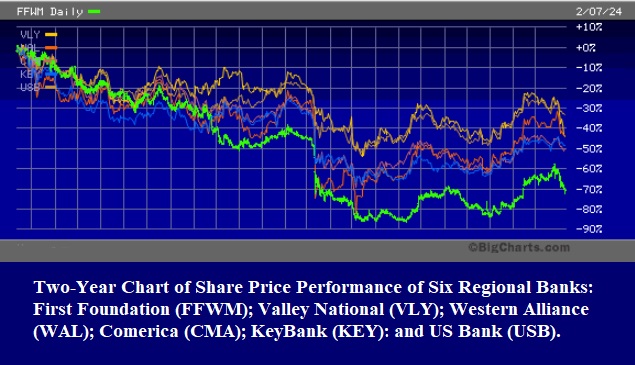By Pam Martens and Russ Martens: February 8, 2024 ~
The S&P 500 closed at a record of 4995.06 yesterday while banks – big, medium, and small – continued to see their share prices hammered. And while the media is focusing the public’s attention on the share price collapse of New York Community Bancorp, which as of yesterday’s closing price is down 56 percent year-to-date and had its credit rating downgraded to junk by Moody’s on Tuesday evening, numerous other banks are trading at their lowest levels in two years.
Below is just a tiny sampling of what’s going on in the U.S. banking system (that you’re not reading about in the mainstream news). The chart above shows the share price performance over the past two years of the six banks described below.
U.S. Bancorp, parent of U.S. Bank, is the 5th largest bank in the U.S. with $663.5 billion in assets as of December 31, 2023 according to its 8K filing with the SEC. The Federal Deposit Insurance Corporation (FDIC) indicates that U.S. Bank operates in 28 states with 2,308 bank branches. The common stock of the parent (ticker USB) has lost over 30 percent of its market value in the past two years.
According to the Federal Reserve’s list of U.S. banks by asset size, KeyBank was the 22nd largest bank in the U.S. as of September 30 of last year, with $186 billion in assets. The FDIC shows KeyBank operates in 16 states with 985 bank branches. The common stock of its parent, KeyCorp (ticker KEY), has lost 50 percent of its value over the past two years.
Comerica was the 32nd largest bank in the U.S. with $86 billion in assets as of the third quarter of last year, according to the Federal Reserve. FDIC data shows it operates in six states with 415 bank branches, predominantly in Michigan, California and Texas. The common stock of Comerica (ticker CMA) has lost 50 percent of its market value in the past two years.
Western Alliance Bancorp, parent of Western Alliance Bank, was the 35th largest bank in the U.S. as of the third quarter of last year with $70.5 billion in assets. The FDIC reports that it currently operates in six states with 38 bank branches, which are predominantly located in Arizona, California, and Nevada. Its common stock price (ticker WAL) was battered during the collapse of Silicon Valley Bank in March of last year. Over the past two years, its shares have lost 45 percent of their market value.
As of September 30 of last year, Valley National Bank was the 37th largest bank in the U.S. according to the Federal Reserve, with assets of $61 billion. FDIC data shows it currently has 237 bank branches, predominantly in New Jersey, New York, Florida, and Alabama. The parent of Valley National Bank, Valley National Bancorp (ticker VLY), has lost 43 percent of its common stock market value in the past two years. The stock closed down 2.33 percent yesterday, at $7.98.
Small regional banks have experienced even more dramatic share price pain. First Foundation Inc., parent of First Foundation Bank (ticker FFWM), has seen its share price lose 70 percent of its market value in two years.
The mega banks have not been immune from the price pain either. Citigroup, Morgan Stanley, Bank of America and Deutsche Bank are all down between 20 to 30 percent over the same two-year time span. In a noteworthy move yesterday, Deutsche Bank closed down 4.62 percent. It is important to remember that the global behemoth, Credit Suisse, blew up during the regional banking crisis in the spring of last year and was taken over by UBS.


